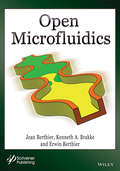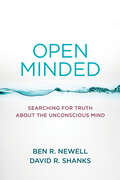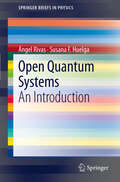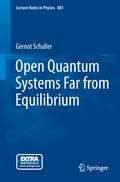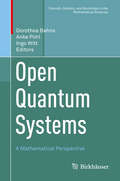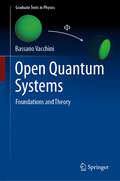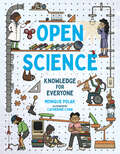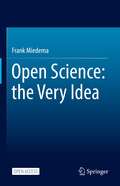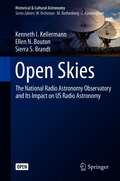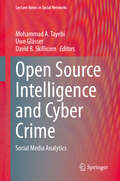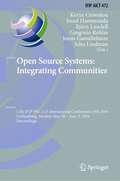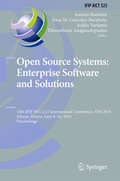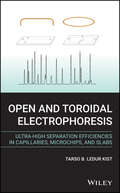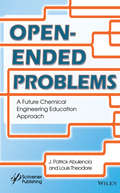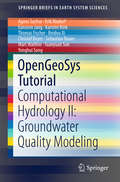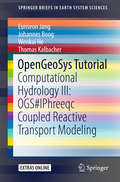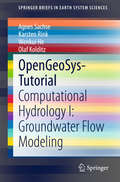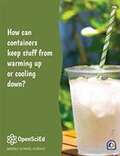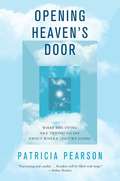- Table View
- List View
Open Microfluidics
by Jean Berthier Erwin Berthier Kenneth A. BrakkeOpen microfluidics or open-surface is becoming fundamental in scientific domains such as biotechnology, biology and space. First, such systems and devices based on open microfluidics make use of capillary forces to move fluids, without any need for external energy. Second, the "openness" of the flow facilitates the accessibility to the liquid in biotechnology and biology, and reduces the weight in space applications. This book has been conceived to give the reader the fundamental basis of open microfluidics. It covers successively The theory of spontaneous capillary flow, with the general conditions for spontaneous capillary flow, and the dynamic aspects of such flows. The formation of capillary filaments which are associated to small contact angles and sharp grooves. The study of capillary flow in open rectangular, pseudo-rectangular and trapezoidal open microchannels. The dynamics of open capillary flows in grooves with a focus on capillary resistors. The case of very viscous liquids is analyzed. An analysis of suspended capillary flows: such flows move in suspended channels devoid of top cover and bottom plate. Their accessibility is reinforced, and such systems are becoming fundamental in biology. An analysis of "rails" microfluidics, which are flows that move in channels devoid of side walls. This geometry has the advantage to be compatible with capillary networks, which are now of great interest in biotechnology, for molecular detection for example. Paper-based microfluidics where liquids wick flat paper matrix. Applications concern bioassays such as point of care devices (POC). Thread-based microfluidics is a new domain of investigation. It is seeing presently many new developments in the domain of separation and filtration, and opens the way to smart bandages and tissue engineering. The book is intended to cover the theoretical aspects of open microfluidics, experimental approaches, and examples of application.
Open Minded: Searching for Truth about the Unconscious Mind
by Ben R. Newell David R. ShanksA provocative look at the unconscious mind that challenges contemporary perceptions and exposes the indefensible science that fostered them.How much of a role does the unconscious play in our decision making? In Open Minded: Searching for Truth about the Unconscious Mind, authors Ben R. Newell and David R. Shanks would argue: not very much. Behavioral science and public discourse have placed an outsized emphasis on the unconscious mind when it comes to understanding human behavior. Pursuing trails of fraud, intrigue, and claims about the power of unconscious thought, Newell and Shanks scrutinize the science that has contributed to our conventional wisdom and offer an important counterpoint to the ever-stronger traction that the unconscious mind has gained in public debate, such as the now ubiquitous claim that unconscious bias plays a large role in people&’s decisions and behavior.Open Minded is divided into two sections: the first examines the modern understanding of the conscious mind, and the second shifts the focus to how to reform current research. Focusing on the core processes of decision making, Newell and Shanks cut through many questionable claims about unconscious behavior. Then, they delve into the nuts-and-bolts of methodology, challenging not only psychology and the behavioral sciences but also medicine and science more broadly. In this against-the-grain approach, Newell and Shanks chart new possibilities for how we may be more open to understanding how our minds actually work.
Open Minds: The Social Making of Agency and Intentionality (The\mit Press Ser.)
by Wolfgang PrinzA novel proposal that the cognitive architecture for volition and cognition arises from particular kinds of social interaction and communication.In Open Minds, Wolfgang Prinz offers the novel claim that agency and intentionality are first perceived and understood in others, and that it is only through practices and discourses of social mirroring that individuals come to apply these features to themselves and to shape their architectures for volition and cognition accordingly. Developing a (social science) constructive approach within a (cognitive science) representational framework, Prinz argues that the architectures for agency (volition) and intentionality (cognition) arise from particular kinds of social interaction and communication. Rather than working as closed, individual systems, our minds operate in ways that are fundamentally open to other minds.Prinz describes mirror systems and mirror games, particular kinds of representational mechanisms and social games that provide tools for aligning closed individual minds with other minds. He maps the formation of an architecture for volition, addressing issues of agency and intention-based top-down control, then outlines the ways the same basic ideas can be applied to an architecture for cognition, helping to solve basic issues of subjectivity and intentionality.Addressing the reality and efficacy of such social artifacts as autonomy and free will, Prinz contends that our beliefs about minds are not just beliefs about their workings but powerful tools for making them work as we believe. It is through our beliefs that our minds work in a particular way that we actually make them work in that way.
Open Quantum Systems
by Ángel Rivas Susana F. HuelgaIn this volume the fundamental theory of open quantum systems is revised in the light of modern developments in the field. A unified approach to the quantum evolution of open systems is presented by merging concepts and methods traditionally employed by different communities, such as quantum optics, condensed matter, chemical physics and mathematical physics. The mathematical structure and the general properties of the dynamical maps underlying open system dynamics are explained in detail. The microscopic derivation of dynamical equations, including both Markovian and non-Markovian evolutions, is also discussed. Because of the step-by-step explanations, this work is a useful reference to novices in this field. However, experienced researches can also benefit from the presentation of recent results.
Open Quantum Systems Far from Equilibrium
by Gernot SchallerThis monograph provides graduate students and also professional researchers aiming to understand the dynamics of open quantum systems with a valuable and self-contained toolbox. Special focus is laid on the link between microscopic models and the resulting open-system dynamics. This includes how to derive the celebrated Lindblad master equation without applying the rotating wave approximation. As typical representatives for non-equilibrium configurations it treats systems coupled to multiple reservoirs (including the description of quantum transport), driven systems and feedback-controlled quantum systems. Each method is illustrated with easy-to-follow examples from recent research. Exercises and short summaries at the end of every chapter enable the reader to approach the frontiers of current research quickly and make the book useful for quick reference.
Open Quantum Systems: A Mathematical Perspective (Tutorials, Schools, and Workshops in the Mathematical Sciences)
by Dorothea Bahns Anke Pohl Ingo WittThis book presents four survey articles on various aspects of open quantum systems, specifically addressing quantum Markovian processes, Feller semigroups and nonequilibrium dynamics. The contributions are based on lectures given by distinguished experts at a summer school in Göttingen, Germany. Starting from basic notions, the authors of these lecture notes accompany the reader on a journey up to the latest research, highlighting new challenges and addressing unsolved problems at the interface between mathematics and physics. Though the book is primarily addressed to graduate students, it will also be of interest to researchers.
Open Quantum Systems: Foundations and Theory (Graduate Texts in Physics)
by Bassano VacchiniThe proposed book is a bridge between the foundations of quantum mechanics and the theory of open quantum systems. The treatment of open quantum systems is a rapidly growing subject, of interest to an ever-increasing number of scientists. The main focus is on overcoming the idealization of perfect isolation of a quantum system, so as to allow for a more realistic treatment and to provide the relevant background for the development of quantum technologies. The book is addressed to students and researchers in the field of open quantum systems and more generally quantum mechanics, a wide community of physicists, mathematicians, and chemists. It is devised both to enter the field and to prepare a series of lectures or a one-semester course on the topic.
Open Science: Knowledge for Everyone (Orca Think #11)
by Monique PolakScience is for everyone, right? Unfortunately, that's not always true. Discovery, research and innovation are often top secret, and big businesses charge high prices for that information. The field of open science is trying to change that. It's all about sharing knowledge. Teams of scientists around the world are working together to improve and speed up scientific research and share their results so that everyone benefits. Open Science: Knowledge for Everyone examines the history of scientific research and how ideas and information are shared and why. It also looks at innovations made using open science, such as treatments for diseases and vaccines to protect against viruses like COVID-19, discoveries that were only possible thanks to the sharing of information. Discover how regular people, including kids, can be citizen scientists and what we all can do to share science and make the world a better place.
Open Science: the Very Idea
by Frank MiedemaThis open access book provides a broad context for the understanding of current problems of science and of the different movements aiming to improve the societal impact of science and research. The author offers insights with regard to ideas, old and new, about science, and their historical origins in philosophy and sociology of science, which is of interest to a broad readership. The book shows that scientifically grounded knowledge is required and helpful in understanding intellectual and political positions in various discussions on the grand challenges of our time and how science makes impact on society. The book reveals why interventions that look good or even obvious, are often met with resistance and are hard to realize in practice. Based on a thorough analysis, as well as personal experiences in aids research, university administration and as a science observer, the author provides - while being totally open regarding science's limitations- a realistic narrative about how research is conducted, and how reliable ‘objective’ knowledge is produced. His idea of science, which draws heavily on American pragmatism, fits in with the global Open Science movement. It is argued that Open Science is a truly and historically unique movement in that it translates the analysis of the problems of science into major institutional actions of system change in order to improve academic culture and the impact of science, engaging all actors in the field of science and academia.
Open Skies: The National Radio Astronomy Observatory and Its Impact on US Radio Astronomy (Historical & Cultural Astronomy)
by Kenneth I. Kellermann Ellen N. Bouton Sierra S. BrandtThis open access book on the history of the National Radio Astronomy Observatory covers the scientific discoveries and technical innovations of late 20th century radio astronomy with particular attention to the people and institutions involved. The authors have made extensive use of the NRAO Archives, which contain an unparalleled collection of documents pertaining to the history of radio astronomy, including the institutional records of NRAO as well as the personal papers of many of the pioneers of U.S. radio astronomy. Technical details and extensive citations to original sources are given in notes for the more technical readers, but are not required for an understanding of the body of the book. This book is intended for an audience ranging from interested lay readers to professional researchers studying the scientific, technical, political, and cultural development of a new science, and how it changed the course of 20th century astronomy.
Open Source Intelligence and Cyber Crime: Social Media Analytics (Lecture Notes in Social Networks)
by Mohammad A. Tayebi Uwe Glässer David B. SkillicornThis book shows how open source intelligence can be a powerful tool for combating crime by linking local and global patterns to help understand how criminal activities are connected. Readers will encounter the latest advances in cutting-edge data mining, machine learning and predictive analytics combined with natural language processing and social network analysis to detect, disrupt, and neutralize cyber and physical threats. Chapters contain state-of-the-art social media analytics and open source intelligence research trends. This multidisciplinary volume will appeal to students, researchers, and professionals working in the fields of open source intelligence, cyber crime and social network analytics. Chapter Automated Text Analysis for Intelligence Purposes: A Psychological Operations Case Study is available open access under a Creative Commons Attribution 4.0 International License via link.springer.com.
Open Source Systems: 12th IFIP WG 2.13 International Conference, OSS 2016, Gothenburg, Sweden, May 30 - June 2, 2016, Proceedings (IFIP Advances in Information and Communication Technology #472)
by Kevin Crowston Imed Hammouda Björn Lundell Gregorio Robles Jonas Gamalielsson Juho LindmanThis book constitutes the refereed proceedings of the 12th International IFIP WG 2.13 International Conference on Open Source Systems, OSS 2016, held in Gothenburg, Sweden, in May/June 2016. The 13 revised full papers presented were carefully reviewed and selected from 38 submissions. The papers cover a wide range of topics related to free, libre, and open source software, including: organizational aspects of communities; organizational adoption; participation of women; software maintenance and evolution; open standards and open data; collaboration; hybrid communities; code reviews; and certification.
Open Source Systems: 14th IFIP WG 2.13 International Conference, OSS 2018, Athens, Greece, June 8-10, 2018, Proceedings (IFIP Advances in Information and Communication Technology #525)
by Ioannis Stamelos Jesus M. Gonzalez-Barahoña Iraklis Varlamis Dimosthenis AnagnostopoulosThis book constitutes the refereed proceedings of the 14th IFIP WG 2.13 International Conference on Open Source Systems, OSS 2018, held in Athens, Greece, in June 2018.The 14 revised full papers and 2 short papers presented were carefully reviewed and selected from 38 submissions. The papers cover a wide range of topics in the field of free/libre open source software (FLOSS) and are organized in the following thematic sections: organizational aspects of OSS projects, OSS projects validity, mining OSS data, OSS in public administration, OSS governance, and OSS reusability.
Open and Toroidal Electrophoresis: Ultra-High Separation Efficiencies in Capillaries, Microchips and Slabs
by Tarso B. Ledur KistPresents the theory and applications of Toroidal Capillary, Microchip, and Slab Electrophoresis to analytical chemists across a range of disciplines Written by one of the developers of Toroidal Capillary Electrophoresis (TCE), this book is the first to present this novel analytical technique, in detail, to the field of analytical chemistry. The exact expressions of separation efficiency, resolution, peak capacity, and many other performance indicators of the open and toroidal layouts are presented and compared. Featuring numerous illustrations throughout, Open and Toroidal Electrophoresis: Ultra-High Separation Efficiencies in Capillaries, Microchips and Slabs offers chapters covering: Solvents and Buffer Solutions; Fundamentals of Electrophoresis; Open Layout; and Toroidal Layout. Confronting Performance Indicators is next, followed by chapters on High Voltage Modules and Distributors; Heat Removal and Temperature Control; and Detectors. The book finishes with an examination of the applications of Toroidal Electrophoresis. The first book to offer a detailed account of Toroidal Electrophoresis—written by one of its creators Compares the toroidal layouts with the well-established open layouts of the three most used platforms (Capillary, Microchip, and Slab) Provides solutions to many of the experimental issues arising in electromigration techniques and discusses the voltage distributors and detectors that are compatible with the toroidal layouts Richly illustrated with a large number of useful equations showing the relationships between important operational parameters and the performance indicators Open and Toroidal Electrophoresis is aimed at method developers and separation scientists working in clinical analysis, and food analysis, as well as those in pharmacology, disease biomarker applications, and nucleic acid analysis using the Capillary, Microchip, or slab Platform. It will also benefit undergraduate and graduate students of inorganic analytical chemistry, organic analytical chemistry, bioanalysis, pharmaceutical sciences, clinical sciences, and food analysis.
Open-Ended Problems: A Future Chemical Engineering Education Approach
by Louis Theodore J. Patrick AbulenciaThis is a unique book with nearly 1000 problems and 50 case studies on open-ended problems in every key topic in chemical engineering that helps to better prepare chemical engineers for the future. The term "open-ended problem" basically describes an approach to the solution of a problem and/or situation for which there is not a unique solution. The Introduction to the general subject of open-ended problems is followed by 22 chapters, each of which addresses a traditional chemical engineering or chemical engineering-related topic. Each of these chapters contain a brief overview of the subject matter of concern, e.g., thermodynamics, which is followed by sample open-ended problems that have been solved (by the authors) employing one of the many possible approaches to the solutions. This is then followed by approximately 40-45 open-ended problems with no solutions (although many of the authors' solutions are available for those who adopt the book for classroom or training purposes). A reference section is included with the chapter's contents. Term projects, comprised of 12 additional chapter topics, complement the presentation. This book provides academic, industrial, and research personnel with the material that covers the principles and applications of open-ended chemical engineering problems in a thorough and clear manner. Upon completion of the text, the reader should have acquired not only a working knowledge of the principles of chemical engineering, but also (and more importantly) experience in solving open-ended problems. What many educators have learned is that the applications and implications of open-ended problems are not only changing professions, but also are moving so fast that many have not yet grasped their tremendous impact. The book drives home that the open-ended approach will revolutionize the way chemical engineers will need to operate in the future.
OpenGeoSys Tutorial
by Thomas Fischer Beidou Xi Agnes Sachse Karsten Rink Sebastian Bauer Erik Nixdorf Eunseon Jang Christof Beyer Marc Walther Yuanyuan Sun Yonghui SongThis tutorial on the application of the open-source software OpenGeoSys (OGS) in computational hydrology is based on a one-week training course at the Helmholtz Centre for Environmental Research in Leipzig, Germany. It provides general information regarding hydrological and groundwater flow modeling and the pre-processing and step-by-step model setups of a case study with OGS and related components such as the OGS Data Explorer. The tutorial also illustrates the application of pre- and post-processing tools such as ArcGIS and ParaView. This book is intended primarily for graduate students and applied scientists who deal with hydrological-system analysis and hydrological modeling. It is also a valuable source of information for practicing hydrologists wishing to further their understanding of the numerical modeling of coupled hydrological-hydrogeological systems. This tutorial is the first in a series that will present further OGS applications in environmental sciences.
OpenGeoSys Tutorial: Computational Hydrology Iii: Ogs-phreeqc Coupled Reactive Transport Modeling (SpringerBriefs in Earth System Sciences)
by Wenkui He Eunseon Jang Johannes Boog Thomas KalbacherThis tutorial on the application of the open-source software OpenGeoSys (OGS) in computational hydrology is based on a one-week training course at the Helmholtz Centre for Environmental Research in Leipzig, Germany. It provides general information regarding hydrological and groundwater flow modeling and the pre-processing and step-by-step model setups of a case study with OGS and related components such as the OGS Data Explorer. The tutorial also illustrates the application of pre- and post-processing tools such as ArcGIS and ParaView. This book is intended primarily for graduate students and applied scientists who deal with hydrological-system analysis and hydrological modeling. It is also a valuable source of information for practicing hydrologists wishing to further their understanding of the numerical modeling of coupled hydrological-hydrogeological systems. This tutorial is the first in a series that will present further OGS applications in environmental sciences.
OpenGeoSys-Tutorial
by Olaf Kolditz Agnes Sachse Karsten Rink Wenkui HeThis tutorial on the application of the open-source software OpenGeoSys (OGS) in computational hydrology is based on a one-week training course at the Helmholtz Centre for Environmental Research in Leipzig, Germany. It provides general information regarding hydrological and groundwater flow modeling and the pre-processing and step-by-step model setups of a case study with OGS and related components such as the OGS Data Explorer. The tutorial also illustrates the application of pre- and post-processing tools such as ArcGIS and ParaView. This book is intended primarily for graduate students and applied scientists who deal with hydrological-system analysis and hydrological modeling. It is also a valuable source of information for practicing hydrologists wishing to further their understanding of the numerical modeling of coupled hydrological-hydrogeological systems. This tutorial is the first in a series that will present further OGS applications in environmental sciences.
OpenSciEd [Unit 6.1: Light & Matter], Why Do We Sometimes See Different Things When Looking at the Same Object? One-Way Mirror
by OpenSciEdNIMAC-sourced textbook
OpenSciEd [Unit 6.2 How Can Containers Keep Stuff From Warming Up Or Cooling Down?]
by NATIONAL CENTER FORNIMAC-sourced textbook
OpenSciEd [Unit 6.4: Plate Tectonics & Rock Cycling], What Causes Earth's Surface to Change? Everest
by OpenSciEdNIMAC-sourced textbook
OpenSciEd [Unit 6.5: Natural Hazards], Where Do Natural Hazards Happen and How Do We Prepare for Them? Tsunami
by OpenSciEdNIMAC-sourced textbook
OpenSciEd [Unit 6.6: Cells & Systems], How do Living Things Heal? Healing
by OpenSciEdNIMAC-sourced textbook
Opening Heaven's Door
by Patricia PearsonPeople everywhere carry with them extraordinary, deeply comforting experiences that arrived at the moment when they most needed relief: when they lost a loved one. These experiences can include clear messages from beyond, profound and vividly beautiful visions, mysterious connections and spiritual awareness, foreknowledge of a loved one's passing--all of which evade explanation by science and logic. Most people keep these transcendent experiences secret--deathbed experiences, Nearing Death Awareness, and shared death experiences. Individuals and families guard them for fear they will be discounted by hyperrational scrutiny. Yet these very common occurrences have the power to console, comfort, and even transform our understanding of life and death. Prompted by her family's surprising, profound experiences around the death of her father and her sister, reporter Patricia Pearson sets out on an open-minded inquiry, a rare journalistic investigation of Nearing Death Awareness. Pearson discovers that roughly half of bereaved people, as well as nurses, hospice workers, soldiers, and others who constantly observe the dying, have had intimations of enduring bonds that can radically help people to process their grief and their fear. Opening Heaven's Door offers deeply affecting stories of messages from the dying and the dead in a fascinating work of investigative journalism, pointing to new scientific explanations that give these luminous moments the importance felt by those who experience them. Pearson also delves into out-of-body and near-death experiences, examining stories and research to make sense of these related but distinct categories that shed light on Nearing Death Awareness. Countless people experience these coincidences when a loved one dies, while others experience such visions while they are dying themselves. These phenomena point toward a larger spiritual reality, and the reality of life (or something else) after death, yet are ignored in a cultural framework that dismisses anything that cannot be explained by the physical brain. But by dismissing or discounting these occurrences, we hamper our own healing. Challenging current assumptions about what we know and what we are still unable to explain, Opening Heaven's Door is a groundbreaking, beautifully written exploration that will forever alter your perceptions of the nature of life and death.
